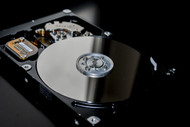SATA vs. SCSI Hard Drives
What's the difference between SATA vs SCSI Hard Drives?
When choosing the right hard drive for your system and needs, the first step, of course, is understanding the differences between the technical capabilities in the diverse formats. From this alphabet soup of hard drive names, we primarily deal with three types: SATA (Serial Advanced Technology Attachment), SCSI (Small Computer System Interface, or scuzzy in tech speak), and SAS (Serial Attached SCSI). For the purposes of this quick summary, we’ll focus on the differences between SATA and SCSI hard drives. And there are many.
Let’s start with SCSI, or the scuzzy. These have been in service for decades in a variety of settings, but, compared to many modern day drive systems, their overall capacity ability is (comparatively) low. SCSI drives will primarily be available in a range that goes from about 36GB to 146GB. For reference, a good fifth generation iPod can round in at 80GB, which is a tremendous storage capacity for storing songs, but maybe not so great for something like the entire contents of your desktop computer (or customer history of a long-term website). When super-sized data is the storage need, SCSIs are rarely going to be the right choice.
However, SCSI hard drives may not have capacity, but they are incredibly fast with access abilities. Most come in between 10,000 to 15,000 RPMs, or double to triple the speed with which the hard drive in a spec desktop will run. This access ability makes SCSI drives very useful when needing a very limited amount of data very quickly. Because of this, SCSIs are put to use often in frontline areas of systems where the ability to access data is more valuable than the data itself. They can be thought of as ignition switches in cars: they have to work every time, and quickly, but they don’t have to do a lot.
SATA hard drives, on the other hand, find their niche in high-capacity ability. If you are reading this on a laptop or desktop, odds are the drive inside is an SATA. None go below 250 GBs in storage ability, and some high-level operating systems reach 2TB (and above). They are also designed to function at high capacity, whereas an SCSI hard drive may be pushed hard to scratch the low-end capacity of what a common SATA can do, and it’s not a guarantee they can do it functionally. Once again, there is a tradeoff; SATA drives are great on data capacity but are often significantly slower.
This is all just a brushing of depth in terms of the true technical differences between SATA and SCSI hard drives. For more information and pricing, always feel free to contact the professionals at TechnoDeals USA at 407-830-7121.
Recent Posts
-
TechnoDeal’s Hard Drive Series – Noteworthy NetApp Hard Drives
NetApp is a reputable brand in the field of enterprise storage solutions, offering cutting-edge sto …Mar 24th 2024 -
Dell's Storage Marvels: A Comprehensive Guide to Optimal Storage Solutions
For the best performance and dependability in the constantly changing world of data storage, sele …Feb 23rd 2024 -
TechnoDeal's Hard-Drive Series - Seagate Specials: Which Hard Drive is for you?
Welcome all,We have seen an increased popularity of Seagate products at TechnoDeals USA over the ye …Jan 24th 2024



